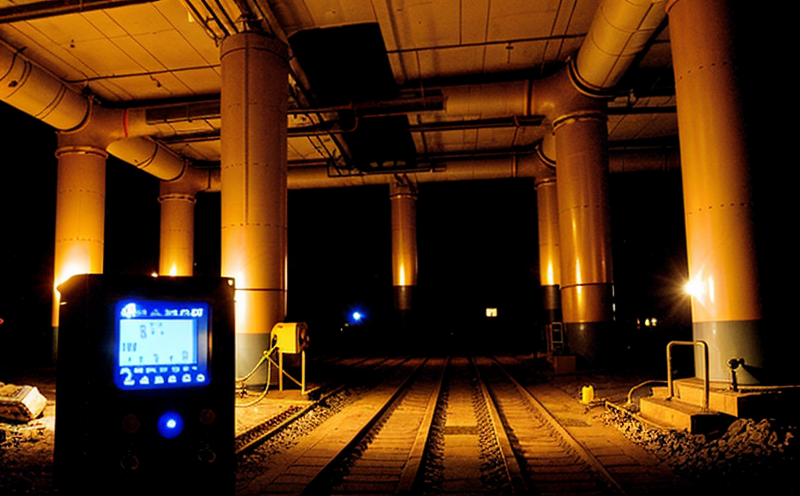ASTM D5072 Radon Concentration in Soil Gas Testing
The ASTM D5072 standard practice provides a method for determining radon concentration in soil gas, which is essential for assessing the potential health risks associated with radon exposure. This test is critical in mining environments where underground structures are common, as radon can accumulate to dangerous levels. The ASTM D5072 protocol utilizes a vacuum extraction system that measures the amount of radon released from the soil into the gas phase.
The testing process involves several steps: first, a borehole is drilled at the desired location within the mining site. A special sampling probe is then inserted into this hole and connected to the vacuum pump. The vacuum creates an area where radon can be drawn out of the surrounding soil, allowing for accurate measurement.
The radon concentration in the extracted gas is measured using a charcoal-based passive diffusion sampler or an active monitor that continuously measures the gas levels. The sample is then analyzed according to ASTM D5072 standards. Compliance with these standards ensures reliable and repeatable results, which are crucial for making informed decisions regarding safety precautions.
Understanding radon concentrations in soil gas is vital for mining operations because it helps identify areas where radon may pose a significant risk to workers' health. By conducting regular tests according to ASTM D5072, mines can implement effective mitigation strategies such as ventilation systems or other protective measures. This not only ensures compliance with regulatory requirements but also contributes to creating safer working environments.
It's important to note that radon is a colorless, odorless gas formed by the natural radioactive decay of uranium in soil and rocks. While it typically remains at low levels outdoors, it can accumulate indoors or underground structures like mines if not properly managed. The U.S. Environmental Protection Agency (EPA) recommends keeping indoor radon concentrations below 148 picocuries per liter (pCi/L). However, when working under ground conditions such as those found in mining environments, the Occupational Safety and Health Administration (OSHA) requires that any detected levels must be addressed promptly.
The ASTM D5072 method is widely recognized for its accuracy and reliability. It has been validated through numerous studies conducted by reputable organizations around the world. Compliance with this standard ensures consistency across different testing sites, enabling accurate comparisons of radon concentrations between locations.
Why It Matters
The importance of ASTM D5072 radon concentration in soil gas testing cannot be overstated, especially within the context of mining operations. Radon is a potent carcinogen that can cause lung cancer if inhaled over extended periods. In enclosed spaces like mines, where ventilation might be limited or non-existent due to operational constraints, the risk of exposure increases significantly.
According to the World Health Organization (WHO), radon is estimated to account for about 10% of lung cancers globally. For those who spend long hours underground without proper protection from radon, their lifetime risk of developing lung cancer could increase by up to 35%. This makes it imperative that mining companies adopt robust testing protocols such as ASTM D5072 to protect both employees and visitors.
Moreover, regulatory bodies like OSHA enforce strict guidelines aimed at minimizing occupational hazards. Failure to comply with these regulations can result in severe penalties including fines or even closure of operations until corrective actions are taken. By adopting ASTM D5072 testing practices, mines demonstrate their commitment to maintaining high standards of safety and health.
From an economic perspective, implementing effective radon mitigation strategies based on reliable test results can also save companies money in the long run by avoiding costly litigation or liability issues related to workplace injuries. Additionally, improved worker safety leads to higher productivity levels since employees are less likely to suffer from illness or disability due to occupational hazards.
Why Choose This Test
- Precision: ASTM D5072 ensures accurate measurement of radon concentrations in soil gas, providing reliable data for decision-making.
- Regulatory Compliance: Adherence to this standard guarantees that tests meet all necessary requirements set by governing bodies.
- Confidence in Results: Using a widely recognized and validated method builds trust among stakeholders regarding the quality and integrity of testing outcomes.
- Ease of Implementation: The straightforward nature of the ASTM D5072 procedure makes it accessible even for smaller mining operations.
The simplicity and effectiveness of ASTM D5072 make it a preferred choice amongst professionals responsible for ensuring worker safety in mine environments. Its ease of implementation allows even small-scale mines to conduct regular tests without requiring extensive technical expertise or expensive equipment.
Use Cases and Application Examples
| Use Case | Description |
|---|---|
| Mine Site Assessment | Determining if a new mine site poses significant radon risks before commencing operations. |
| Ongoing Monitoring | Regular checks to ensure that radon levels remain within acceptable limits post-construction or after modifications are made to existing facilities. |
| New Construction Projects | Evaluating the suitability of a new mine site for construction by assessing initial radon concentrations before any excavation begins. |
- Initial Screening: Conducting preliminary tests to identify potential problem areas early on in the project lifecycle.
- Compliance Verification: Ensuring that all testing conducted adheres strictly to ASTM D5072 guidelines for accurate and consistent results.
- Data Collection & Analysis: Gathering comprehensive data about radon levels over time to monitor trends and inform future decisions regarding safety measures.
Incorporating ASTM D5072 into your mine site assessment or ongoing monitoring program can help ensure compliance with regulatory standards while providing valuable insights into the potential risks associated with radon exposure. This information is crucial for developing effective mitigation strategies that protect both employees and visitors alike.





